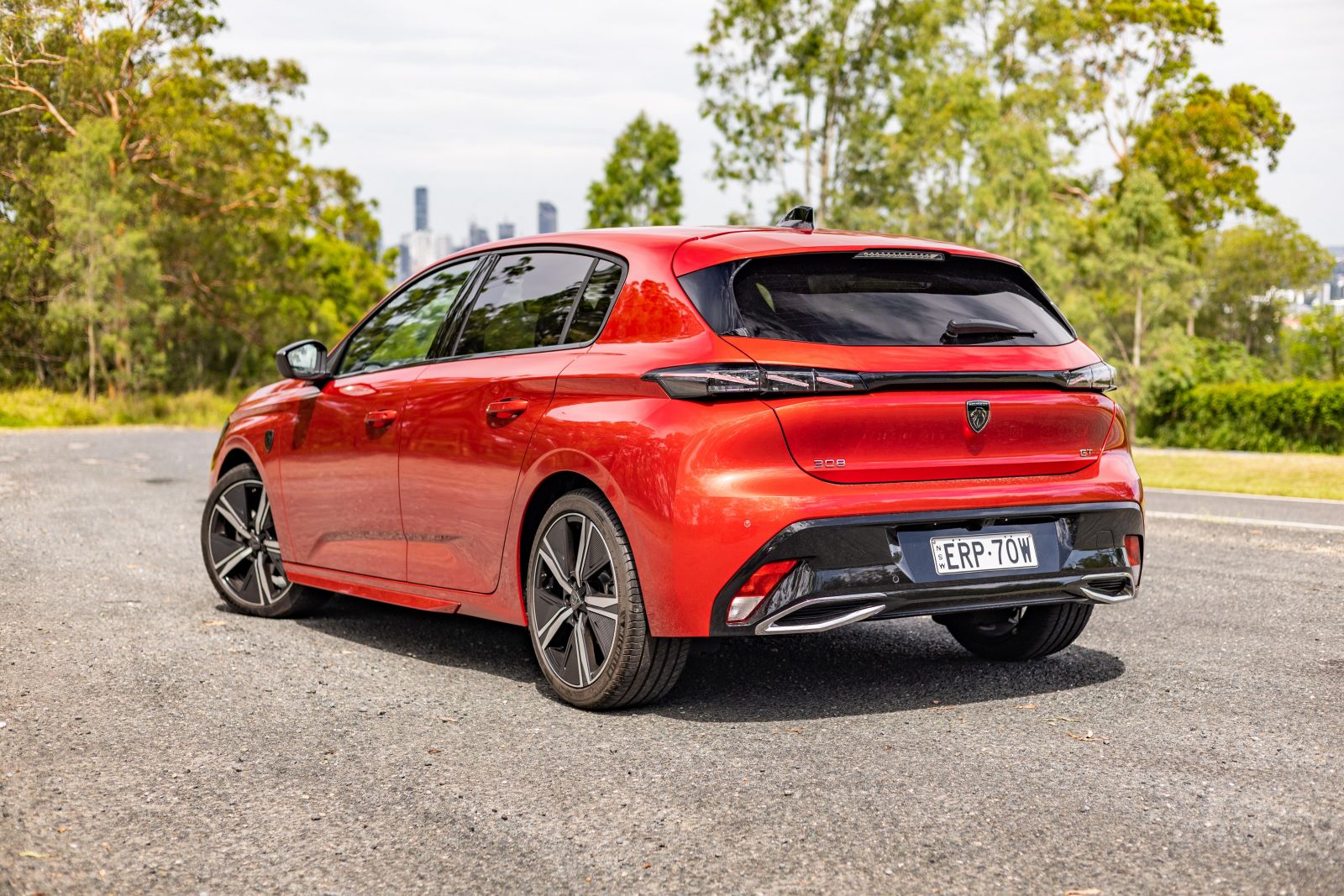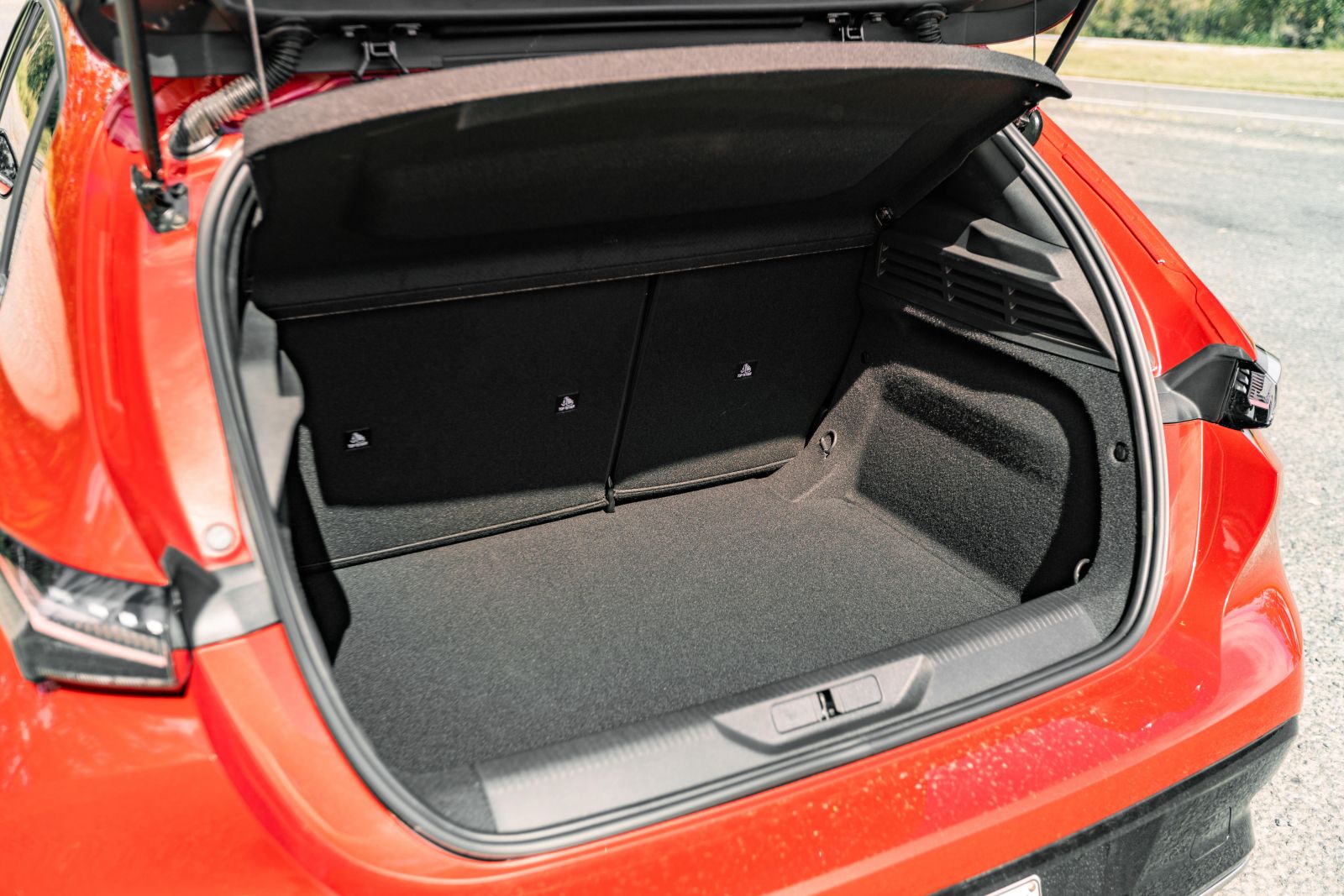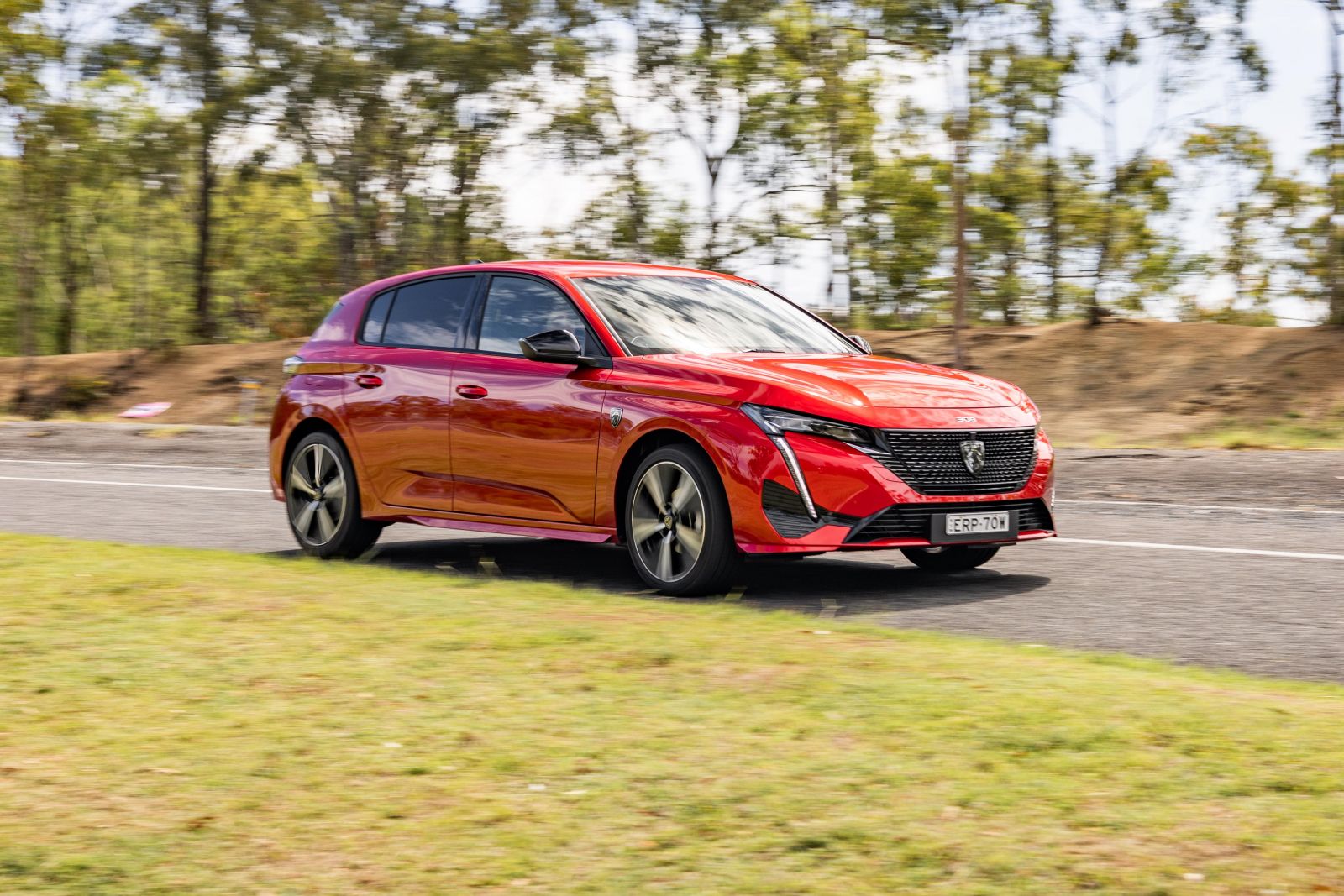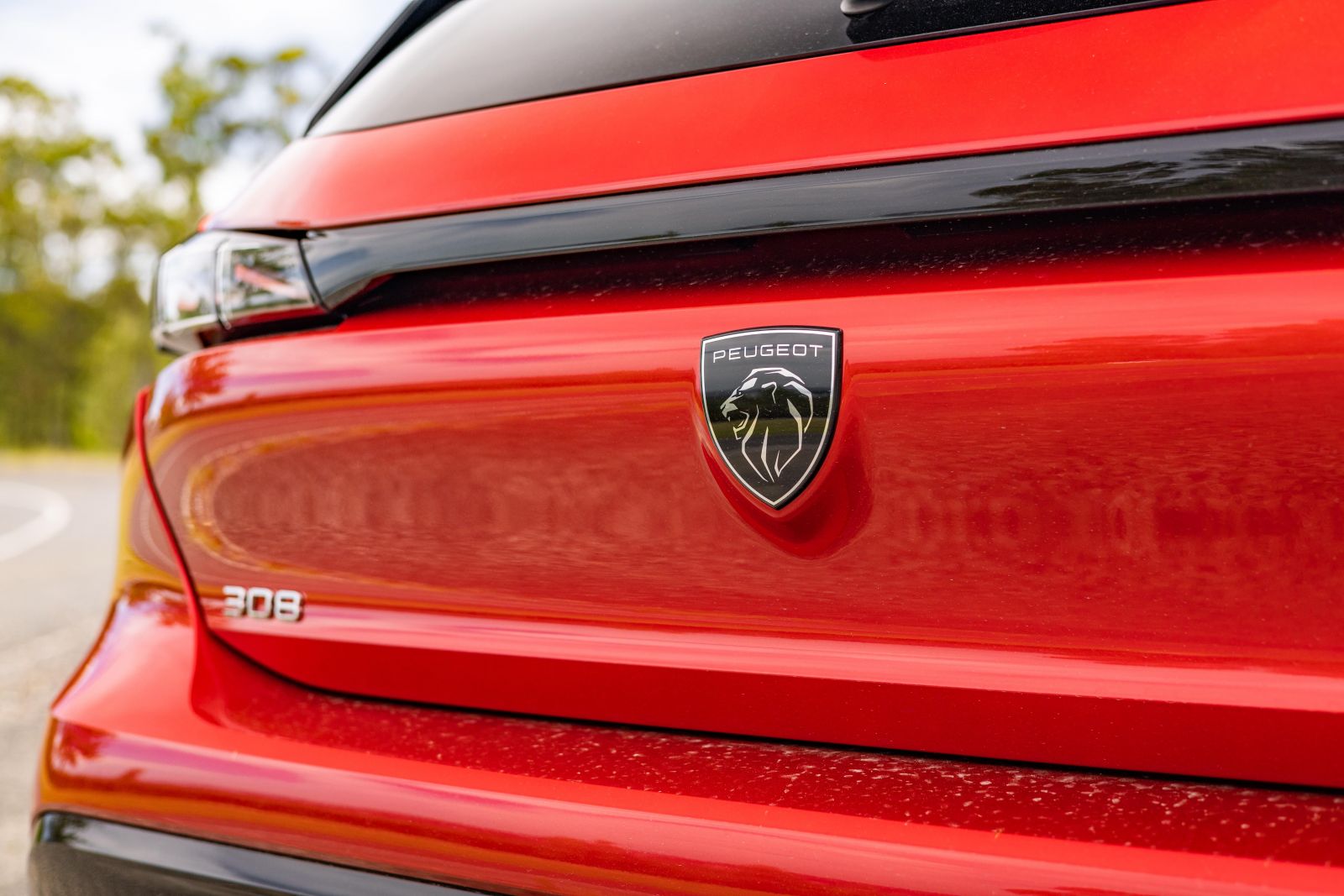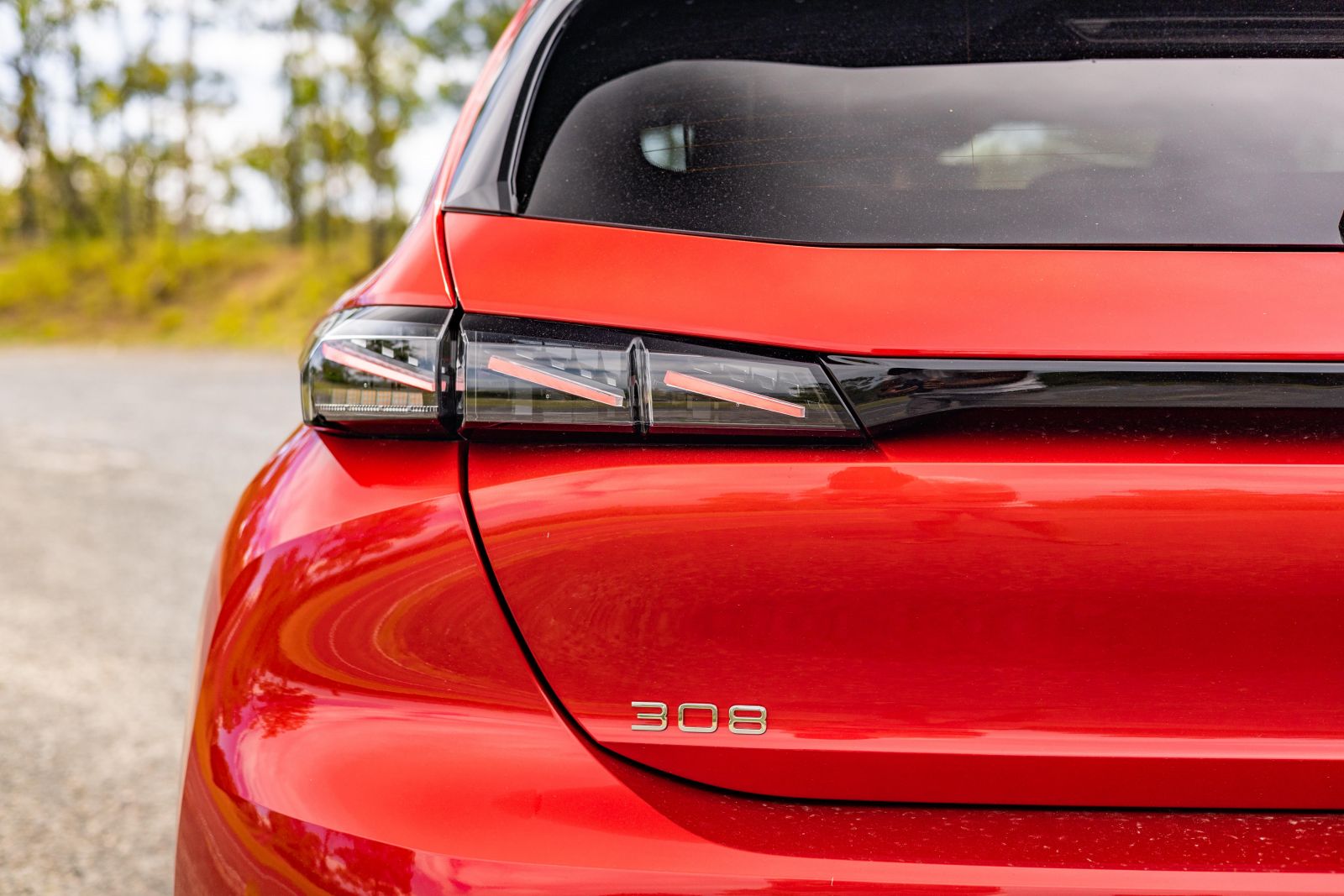Peugeot has been enjoying a design renaissance of late, not that it desperately needed one. After all, the previous-generation 308 was a handsome thing, and certainly more attractive than its fish-mouthed predecessor.
But the new Peugeot 308 debuts the latest evolution of the brand’s design language that started with the 2008, 3008, 5008 and 508, with a mix of gentle curves and sharp creases.
It’s not as beautiful as the 508 or as handsome as the 3008 – it’s a bit chunky-looking, with a high belt line and a pinched rear – but it certainly captures your attention.
Highlights include the plunging daytime running lights up front and the cute unlocking animations of the tail lights.
The interior is particularly appealing, putting some luxury-brand rivals to shame in the design stakes. More on that later.
Peugeot isn’t the volume player here that it is in Europe and the small car segment continues to decline, so the 308 won’t be a big seller here.
Nevertheless, with a small, focused range of highly specified variants and a style like nothing else in its segment, the 308 should be able to carve out a small niche for itself.
How much does the Peugeot 308 GT cost?
The GT hatchback represents the entry point to the Peugeot 308 range, and is priced at $43,990 before on-road costs. Based on a New South Wales postcode, that’s a drive-away price of $48,254.
Olivine Green metallic paint is standard, with Artense Grey and Nera Black costing an extra $690 and Vertigo Blue, Pearl White, and the featured Elixir Red each costing an extra $1050.
The green is not only the most stunning colour in the palette, it’s one of the most beautiful finishes on the market. That it’s the standard paint makes it a no-brainer, unless you really hate green.
The 308 is priced well above top-spec versions of the Kia Cerato, Toyota Corolla and Hyundai i30 – unless you opt for the spicy N version of the latter – but undercuts even the most affordable luxury-brand rivals by several thousand dollars. The Audi A3 range, for example, opens at $47,700 before on-roads.
Similarly priced rivals for the 308 include:
Mazda recently confirmed it’s reshuffling its 3 line-up, with the updated range due in July. In the meantime, it tops out at $43,310 before on-roads for the soon-to-be axed X20 Astina.
Peugeot may be a mass-market brand in Europe but it has a quasi-premium positioning in Australia, which explains the pricing as well as the absence of any variants below the well-specified GT.
What is the Peugeot 308 GT like on the inside?
The 308 is a direct rival to the Golf, which makes it all the more surprising just how much classier its interior is.
Seriously, the Peugeot’s interior seems more at the level of luxury-brand small cars like the Audi A3. Instead of a functional but austere cabin like in the Golf, there’s a distinctive layout and superb material choices.
It’s not just style over substance, either. The 308 has arguably class-leading storage in the front of the cabin. The centre console bin, which has an elegant two-piece lid, is a cavernous pit much like that in the larger 3008. It’s illuminated, and the storage cavity extends under the cupholders.
There’s a wireless charging pad on the centre stack and cupholders on the centre console, but you’ll also find another nook in between them which you can stick your whole hand into. The glove compartment is spacious, and the bottle holders in the doors can easily swallow 1L bottles – and they’re carpeted, too.
Gloss black trim has been kept to a minimum, though you’ll find some on the steering wheel where it’s bound to attract smudges. There’s grey metal-look trim running across the dash which looks better than gloss black but can result in glare on the windscreen.
These trim pieces aside, material choices are top-notch. Soft-touch plastic is used across the top and front of the dashboard, as well as the top of the front door cards. Alcantara is also swathed across the dashboard and doors, while each door has a leatherette-trimmed armrest. Leatherette wrapping is also found along the sides of the centre console.
It’s all finished off with lime green stitching details. Yes, there’s quite a bit going on visually, but we think it’s a classy cabin overall.
The seats also feature Alcantara trim, and those up front are wonderfully grippy with good bolstering. It did take a while to find a suitable seating position, however; it’s not as easy to get a perfect vantage point of the high-mounted instruments as in the larger 3008.
After some adjustments I found a comfortable seating position that afforded enough clearance between the wheel and my thighs.
Peugeot seems to have made neon green its signature colour, and you’ll find it on the screens and the ambient lighting. Don’t like green? That’s easily fixed, as you can adjust the colour theme of the screens and toggle between multiple ambient lighting colours.
Strangely, there are a handful more colours with the latter.
The new-generation infotainment system is a step up on the old system, with a more intuitive menu structure and crisp graphics including attractive transitions. We could do without the tips pop-up every time we started the car, however.
The 308 also gets a slick new touch panel below the screen containing shortcuts, in addition to a tier of physical switchgear, which includes a handy Home shortcut. It does attract smudges, however.
As with other recent Peugeots, there are no physical climate controls but there are shortcuts on the screen plus a climate ‘home’ button on the centre stack. You can also use “Hey Peugeot” voice prompts to adjust climate settings.
The air-conditioning system itself is disappointing. The air seems to come in fits and bursts, without a consistent stream of cold air. You can adjust the temperature to as low as 15 degrees, but it takes a while to cool the cabin.
The digital instrument cluster is mounted nice and high, which allows Peugeot to get away with not offering a head-up display. It has a cool 3D effect but didn’t hurt my eyes, and there’s also a map view though it’s nowhere near as detailed as that of its Volkswagen rival’s Digital Cockpit.
The gear shifter is a stubby little thing, even smaller than that of the Golf. It sits on a raised section of the centre console, ahead of the drive mode selector.
The pinched rear and high beltline affect visibility, which isn’t great out the back. The GT also has Peugeot’s disappointing 180-degree camera, and you’ll need to step up to the GT Premium to get a 360-degree unit.
The high beltline, along with a thick C-pillar, also means the back seat is a bit gloomy. It’s not as confining as the rear of the Mazda 3, but passengers commented it didn’t feel all that airy and spacious. Nevertheless, I was able to sit behind my own seating position with enough knee room and head room to be comfortable and I’m 180cm tall.
Lift up the tailgate and you’ll find a competitive 412L of cargo space, expanding to 1323L with the rear seats folded. However, the 308 does without even a space-saver spare, with Peugeot only offering a tyre repair kit.
There’s a walk away function for the proximity key, which works seamlessly. Simply walk away with the key on you and the car will beep and lock.
One final note: we appreciate the 308 telling you what wiper setting you’ve put it on when you move the stalk.
What’s under the bonnet?
As with all 308s in Australia bar the range-topping plug-in hybrid, the base GT uses a turbocharged 1.2-litre three-cylinder engine producing 96kW of power at 5500rpm and 230Nm of torque at 1750rpm.
Those outputs are nothing special at this price point. The petrol Civic pumps out 131kW and 240Nm, the Golf 110TSI 110kW and 250Nm, and a Mazda 3 with the 2.5-litre engine produces 138kW and 242Nm. The Cupra Leon V has them all beat with 140kW and 320Nm.
The official combined cycle fuel economy claim is 5.3L/100km, but we observed 7.8L/100km on a loop consisting of inner-city, suburban and highway driving, and ended up with an abysmal 10.2L/100km over the course of a week.
While that did include inner-city commuting and some spirited mountain driving, that’s almost twice the official claim. It requires 95 RON premium unleaded fuel, too.
How does the Peugeot 308 GT drive?
The Peugeot 308 has a genuinely talented chassis and capable handling, but it’s let down by a lethargic powertrain.
The three-pot simply feels underdone in this 1258kg hatchback, and the transmission needs some finessing, too.
There’s an odd low-speed jerkiness to the 308, similar to that which you’ll find with less refined dual-clutch transmissions. It’s particularly apparent when you’re creeping through traffic.
Alas, you get this similar foible without the snappy shifts of a DCT. The 308 simply doesn’t feel all that zippy, even in the daily commute, with a noticeable delay off the line.
On one occasion, we were travelling at 50km/h and, when encountered with only the slightest of grades, the 308 had to shuffle all the way back to second. The economy-minded transmission also is very quick to shift up to the highest gear possible.
The three-pot’s gritty thrum has a charm to it at first, but in more adventurous driving one gets tired of the soundtrack. It can get vocal when you’re pushing it, and on some roads you’ll need to.
Sport mode adjusts the shift points but it holds onto gears until the car is screaming. We tried it once and promptly turned it off. Credit to Peugeot, however, for always displaying what gear you’re in regardless of whether you’re manually shifting or not.
I took this to Mt Glorious in Brisbane, as I tend to do, and found the lack of punch from this powertrain frustrating. Meanwhile, I’ve tackled the same roads in a Ford Puma, which has less power and torque but an almost identical tare weight and a dual-clutch auto, and had an absolute blast. Something’s not adding up here.
It’s not for lack of handling ability. The 308 can hang in there on tight turns, and stays nice and flat with minimal understeer. Body control is excellent, and the steering is a particular high point.
It feels nice and meaty, with a chunky, tactile wheel – don’t worry, you get used to the small size. That the steering can also feel light and direct when you’re puttering through parking lots instead of tearing up twisties makes the 308’s tiller a good all-rounder.
Oddly, the stability control light was prone to flashing, even when simply taking off from a stop, and that’s certainly not because there’s too much power on tap. We’d suggest this system needs a little more fine-tuning; a flickering ESC light is something we’ve observed in other Peugeots like the 2008 too.
What is superbly tuned is the suspension. Ride comfort is excellent: it’s firm but nicely damped, and it’s never uncomfortable even on unsealed roads.
We didn’t feel any crashes in the cabin, even though it uses a less sophisticated twist-beam rear axle.
Tyre noise can be an issue over coarse-chip roads, and the cabin gets quite boomy.
The over-speed alert chime is subtle: take note, Kia and Hyundai. But the lack of an auto hold function is frustrating, given how common this is in this segment.
There is a standard automatic stop/start system and it’s well calibrated, seamlessly turning the engine on and off without being overzealous about it.
We must also praise the standard Matrix LED headlights, which provide superb illumination and auto-dimming smarts.
What do you get?
308 GT highlights:
- Matrix LED headlights
- LED tail lights incl. 3D claw effect
- 18-inch Kamakura alloy wheels
- Peugeot 3D i-Cockpit
- 10-inch 3D digital instrument cluster
- 10-inch HD touchscreen infotainment system
- Wireless Apple CarPlay, Android Auto
- AM/FM/DAB radio
- Alcantara seats with leather-effect bolsters
- Adamite Green top stitching
- Leather multifunction steering wheel
- 8-colour ambient lighting
- Frameless electrochromatic rear-view mirror
- Auto climate control with clean air function
- Electric, heated, power folding mirrors
- One-touch electric windows front, rear
- Acoustic tinted windscreen
- Keyless entry, push-button start
- Wireless phone charger
- 6-speaker audio
- 2 x USB front (1 x USB-A, 1 x USB-C)
- 2 x USB rear (1 x USB-A, 1 x USB-C)
- Front, rear parking sensors
- Visio Park 180-degree reversing camera
308 GT Premium adds:
- 18-inch Portland matte black alloys
- Panoramic opening glass sunroof
- Hands-free electric tailgate (GT Premium Wagon)
- Nappa leather with charcoal grey top stitch
- Electric driver’s seat
- Heated front seats
- Massage function for front seats
- 2-position adjustable boot floor (GT Premium Wagon)
- Active Lane Positioning Assist (centring)
- 360-degree HD cameras (front, rear)
- Focal 10-speaker premium audio (GT Premium Hatch)
308 GT Sport Hatch Plug-In Hybrid adds:
- Acoustic vehicle alert system
- Hybrid drive mode
- Mode 2 type 2 cable
Is the Peugeot 308 safe?
The Peugeot 308 has a four-star ANCAP safety rating based on testing conducted by Euro NCAP.
It received a score of 79 per cent for adult occupant protection, 86 per cent for child occupant protection, 68 per cent for vulnerable road user protection, and 82 per cent for safety assist.
Standard safety features include:
- 6 airbags
- Autonomous emergency braking (AEB)
- Low-light Pedestrian, Cyclist detection
- Auto post-collision braking
- Adaptive cruise control incl. stop/go function
- Blind-spot monitoring
- Rear cross-traffic alert
- Driver attention warning
- Lane keep assist
- Reversing camera
- Speed sign recognition, recommendation
- Tyre pressure monitoring
308 GT Premium adds:
- Active Lane Positioning Assist (centring)
How much does the Peugeot 308 GT cost to run?
The 308 is backed by a five-year, unlimited-kilometre warranty.
Servicing is required every 12 months or 15,000km, and Peugeot offers three- and five-year servicing plans priced at $1100 and $1900, respectively.
That’s in line with the Golf, though more expensive than a Mazda 3 ($1700 over five years) or a Civic ($995).
CarExpert’s Take on the Peugeot 308 GT
The Peugeot 308 is a lovely car crying out for more power.
There’s a gaping chasm between the three-cylinder GT and the flagship plug-in hybrid GT Sport, where an engine more competitive with that of rivals like the Cupra Leon and Honda Civic could sit.
If you’re looking for hot or even warm hatch performance, you won’t find it here. Rivals are simply more fun to drive as, though the 308 has a lovely chassis, its powertrain feels underdone.
If what you’re after is a well-appointed, stylish small hatch with no real pretensions of performance, however, the 308 makes a strong case for itself.
Its interior is arguably the most attractive in its segment and storage is excellent, though second-row space is mid-pack at best.
It’s not cheap, but it sits at a similar price point to a Civic or a Golf R-Line; if you want value for money, you would be better served by an i30 or Cerato, but they feel much less special inside.
You could spend more and get a 308 GT Premium which includes some serious luxury equipment, but the base GT arguably strikes the best balance within the 308 range.
Click the images for the full gallery
MORE: Everything Peugeot 308

